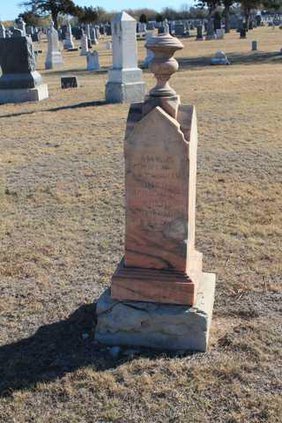Cemeteries are a fascinating snapshot of a community’s historical timeline, a proud and permanent museum for those who came before and helped shape the identity and personality of every community across North America.
The Great Bend Cemetery offers a fascinating look at the town’s historical timeline starting at the beginning when the town was first founded in the 1870s, with “residents” who helped build the city’s social and physical infrastructure, fought in every U.S. war since the Civil War, as well as those who found their final resting place on route to where their families would find a new start in life.
This week, as we celebrate the modern American version of Halloween, it’s a good time to look back into the origins of the day. Throughout history, the world over, as the days shorten and the leaves turn and fall, people have acknowledged the passing of life, with All Hallows Eve, All Saints Day, Samhain, and the Mexican celebration of The Day of the Dead. A visit to a cemetery to visit departed loved ones may soothe the soul and help fill in some blanks on the family tree. But even if the family burial plot is hundreds of miles away, there is tranquility--and history--to be found at the local cemetery, if you take the time to look.
A short drive along the lanes of the Great Bend Cemetery is all it takes to learn the oldest plots begin at the north west, with the newest to the south and east additions. For those searching for a specific plot, stop into the cemetery office at the main entrance off Broadway and one of the cemetery employees can look up the name and provide a cemetery map with the plot highlighted and simple directions to find the spot.
“We get a lot of people researching their ancestry,” said Michelle Davis, a cemetery employee. “It’s really interesting hearing their stories about their relatives.”
Davis said there are good records dating back to 1930, but prior to that, records become spotty. A fire may have wiped out earlier records, which were also incomplete.
“Often, women were simply recorded with the surname of their husbands, as in Mrs. Smith, so it is unclear exactly which Mrs. Smith they might be,” she said. “Also, sometimes we aren’t even certain if anyone was actually buried there or not.”
A group called Find a Grave sometimes tracks down graves for people researching their ancestry, and when Davis or others can’t locate the grave, they offer information about other closeby cemeteries that may hold the remains of those who are sought.
A short drive along the lanes is all it takes to find the northwest section is where the oldest graves lie, in section P. Here, pioneers and lawmen lie in unmarked graves next to settlers like Amy Langham, age 26 at her death in 1887. She is memorialized with a marker carved from an unusual pink-orange colored marble. It is also the area where famous black movie producer Oscar Micheaux.
In Section Q, a large plot called Moses hill sits, just north of the circular memorial to Civil War veterans who belonged to the fraternal organization Grand Army of the Republic. An early sheriff and an early mayor of Great Bend are buried there. Only a few rows to the east is lies Britt Spaugh, creator of the Great Bend Zoo, and whom the Britt Spaugh Park is named after. He lies next to his parents. A little further east, in Section R, the William Townsley family is buried. William was the son of the founder of the Great Bend Tribune, and subsequent owner of the newspaper. After his death in 1935, his wife Alice continued to own it, and son Russell Townsley ran it. Later, Russell moved to Russell and ran the paper in that town, and her daughter Helen Coogan and her husband briefly took the reins until Mr. Coogan was called back to an international post with the United Press. Alice’s son Bill then took over, according to local historians, and eventually sold it to the Kansas City Star. Alice and William are buried on the east side of the Townsley monument, and daughter Helen Townsley Coogan and her husband are buried on the west side. They lie next to Andress monument. Charles Andress, a circus owner, headed the family, and too was a colorful character in Great Bend’s past.
Most cemeteries have a section referred to as “Potters Field”, which is where those without family or resources were buried without ceremony or markers. Great Bend Cemetery is no different. According to Karen Neuforth, historian at the Barton County Historical Society museum, Potters Field was located on the western boundary of the present cemetery. Among those buried there are victims of the 1882 smallpox epidemic that took fifteen Great Bend lives that December. As memories of the tragedy faded, she said, Potters Field was forgotten, and wasn’t discovered until July 1962 when trenching crews struck unmarked graves. There were estimated to be 30 or more graves there, and the city purchased the land and annexed it to the existing cemetery in October of that year.
For more information about the history that can be found at the Great Bend Cemetery, read the article by Karen Neuforth in the June 2011 edition of the Barton County Historical Society’s Village Crier. It can be accessed at http://bartoncountymuseum.org/crier_Jun11.pdf. The story Tragedy and Triumph: Smallpox, can be found in the March, 2009 edition at http://bartoncountymuseum.org/crier_Mar09.pdf.
Great Bend Cemetery is only one of several cemeteries spotlighted in the self-guided Great Bend Area Cemetery Tour which is available free at the Great Bend Convention and Visitors Bureau at 3007 10th Street.
History abounds in Great Bend Cemetery
Take time out to explore Great Bends past





